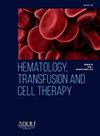单机构观察儿童急性白血病化疗的远期和晚期疗效及其处理
IF 1.6
Q3 HEMATOLOGY
引用次数: 0
摘要
急性淋巴细胞白血病(ALL)仍然是儿童最常见的恶性疾病,约占儿科肿瘤诊断的26%。现代治疗方法,特别是多药化疗方案,如BFM方案,显著提高了5年生存率,达到96%。然而,化疗方案的毒性,特别是晚期效应,对长期生活质量和临床结果产生负面影响。这些不良反应包括心脏毒性、继发性恶性肿瘤、内分泌功能障碍和神经损伤。鉴于传统治疗方案的局限性,探索毒性更小、更有效的治疗策略至关重要。目的•探讨化疗对儿科急性淋巴细胞白血病患者的晚期影响。•为这些影响的早期发现和管理提出有效的策略。•将阿塞拜疆适用的BFM议定书与国际经验进行比较。材料和方法本研究包括2020年至2023年间在阿塞拜疆国家血液学中心诊断为ALL并接受治疗的120名儿科患者。对患者记录进行回顾性分析。使用国际标准化方法评估晚期化疗效果:•心脏毒性:超声心动图和亲bnp生物标志物测量。•神经毒性:临床神经学评估和电生理测试。•内分泌功能障碍:甲状腺功能测试,胰岛素抵抗评估和生长激素监测。继发性恶性肿瘤:长期随访和生物分子分析。结果38%的患者出现各种迟发性不良反应。主要毒性类型的发生率如下:结论本研究表明,在阿塞拜疆,采用BFM方案治疗的儿科患者化疗具有显著的晚期效应。研究结果强调了实施常规监测机制的重要性,特别是对心脏毒性和内分泌功能障碍。国际文献表明,将CAR-T细胞疗法和blinatumomab等靶向疗法等新型治疗药物纳入治疗方案可能会改善临床结果。本文章由计算机程序翻译,如有差异,请以英文原文为准。
LONG-TERM AND LATE EFFECTS OF CHEMOTHERAPY IN CHILDHOOD ACLEUKEMIA AND THEIR MANAGEMENT SINGLE INSTITUTION OBSERVATIONUTE LYMPHOBLASTIC
Introduction
Acute Lymphoblastic Leukemia (ALL) remains the most common malignant disease of childhood, accounting for approximately 26% of pediatric oncology diagnoses. Modern treatment approaches, particularly multi-agent chemotherapy regimens such as the BFM protocol, have significantly improved 5-year survival rates, reaching up to 96%. However, the toxicity of chemotherapy regimens, particularly late effects, negatively impacts long-term quality of life and clinical outcomes. These adverse effects include cardiotoxicity, secondary malignancies, endocrine dysfunction, and neurological damage. Given the limitations of conventional treatment protocols, exploring less toxic and more effective therapeutic strategies is of critical importance.
Objective
• To identify the late effects of chemotherapy in pediatric patients treated for ALL.
• To propose effective strategies for the early detection and management of these effects.
• To compare the BFM protocol applied in Azerbaijan with international experiences.
Materials and methods
This study includes 120 pediatric patients diagnosed with ALL and treated at the National Hematology Center of Azerbaijan between 2020 and 2023. A retrospective analysis of patient records was conducted. The evaluation of late chemotherapy effects was performed using internationally standardized methodologies:
• Cardiotoxicity: Echocardiography and pro-BNP biomarker measurements.
• Neurotoxicity: Clinical neurological assessment and electrophysiological testing.
• Endocrine dysfunction: Thyroid function tests, insulin resistance evaluation, and growth hormone monitoring.
• Secondary malignancies: Long-term follow-up and biomolecular analyses.
Results
Among the analyzed patients, 38% exhibited various late-onset adverse effects. The incidence rates of key toxicity types were as follows:
Conclusion
This study demonstrates the significant late effects of chemotherapy in pediatric patients treated with the BFM protocol in Azerbaijan. The findings emphasize the importance of implementing routine monitoring mechanisms, particularly for cardiotoxicity and endocrine dysfunction. International literature suggests that incorporating novel therapeutic agents, such as CAR-T cell therapy and targeted therapies like blinatumomab, into treatment regimens may improve clinical outcomes.
求助全文
通过发布文献求助,成功后即可免费获取论文全文。
去求助
来源期刊

Hematology, Transfusion and Cell Therapy
Multiple-
CiteScore
2.40
自引率
4.80%
发文量
1419
审稿时长
30 weeks
 求助内容:
求助内容: 应助结果提醒方式:
应助结果提醒方式:


